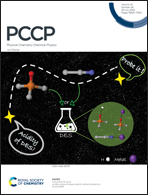A theoretical perspective of the relationship between the structures and luminescence properties of red thermally activated delayed fluorescence molecules†
Abstract
Orange and red thermally activated delayed fluorescence (TADF) emitters have shown promising applications in organic light emitting diodes (OLEDs) and the bio-medical field. However, both the species and amounts of orange and red molecules are far from meeting the requirement for practical applications; this is due to the lack of systematic studies on the relationship between molecular structures and luminescence properties. Herein, the excited state dynamic processes and photophysical properties of six donor–acceptor (D–A) type orange-red TADF molecules, which possess the same acceptor, are theoretically studied in toluene by using the polarizable continuum model (PCM). Based on density functional theory (DFT) and time-dependent density functional theory (TD-DFT) calculations coupled with the thermal vibration correlation function (TVCF) method, the adiabatic singlet–triplet energy gaps, natural transition orbital properties, reorganization energies, hole and electron distributions, and the radiative and non-radiative as well as the intersystem crossing (ISC) and reverse intersystem crossing (RISC) processes are theoretically analyzed. The results indicate that remarkable geometric changes between the lowest singlet excited state (S1) and the ground state (S0) are mainly caused by the rotation of the donor unit for NAI-R2, NAI-R3 and NAI-DPAC, and the reorganization energy is mainly contributed by the dihedral angle. However, for NAI-DMAC, BTDMAc-NAI and BFDMAc-NAI, remarkable geometric changes are found in the acceptor unit with large contribution of reorganization energy by bond length. These variations bring different non-radiative energy consumption processes. Moreover, small energy gaps between S1 and the lowest triplet excited state (T1) are determined for all studied molecules and an efficient RISC process is detected. Furthermore, enhanced conjugacy in the donor unit and remarkable intramolecular interactions are determined for BTDMAc-NAI and BFDMAc-NAI, which is helpful to promote the up-conversion process. Our investigations give reasonable explanations for previous experimental measurements and the relationship between basic structures and luminescence properties is revealed, which could facilitate the development of new efficient TADF emitters.



 Please wait while we load your content...
Please wait while we load your content...